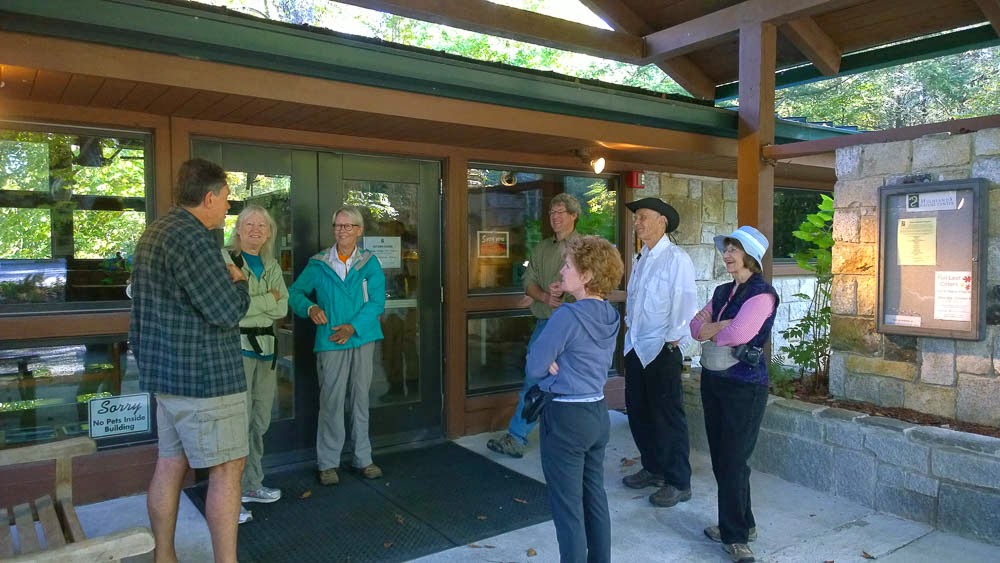We started out at the Highlands Biological Station where we visited the largest tree in the garden which was a Tulip Poplar. We then walked along the W. C. Coker Rhododendron Trail to see the Hemlock cove with actual living hemlocks - something that has become sadly rare with the infestation of the adelgid. We were also treated to the sight of three Monarch butterflies (or the same one visiting us three different times).
From there we went to Peggy Crosby Center where we saw a European Silver Fir along with several other giant conifers including Oriental spruce, Nordmann fir and California incense cedar, all planted by forester Tom Harbison 80+ years ago. We were introduced to Dr. Gary Wein, Botanist and Executive Director and Herpetologist, and Kyle Pursel, Stewardship Coordinator; both with Highlands-Cashiers Land Trust who provided the distinct privilege of viewing the Cheoah Hemlock which is the largest surviving hemlock in the world., ( protected by Highlands-Cashiers Land Trust). This was a breathtaking experience. We are grateful not only to Gary and Kyle and Jeff for their passionate enthusiasm and dedication as well as their expert tutelage but to all those who have worked to conserve these untouched habitats preserving them for future generations.
At this point, I did not think the day could be topped but I was wrong. The Historic High Hampton Inn provided us with a virtual smorgasboard of giant trees including six state champion trees, one potential national champion and what many claim is the largest baldcypress, standing over 140 feet. The 1400 acre property is partly under two conservation easements with the Highlands-Cashiers Land Trust and is full of large maples, poplars, hickories and magnolia trees. The Champion trees include a Kentucky coffee tree, an umbrella magnolia--the contender for the fall 2012 National Register of Big Trees--a bottlebrush buckeye, a Nordmann fir, mistakenly signed as a Fraser fir, an alternate-leaf dogwood, and a black locust. Kathy Stilwell
Julie Ross provided this excellent review of the trip:
"Flowers are beautiful -- but trees are majestic. Perhaps that is why Joyce Kilmer wrote "I think that I shall never see, A poem lovely as a tree." The many trees we saw in Highlands and Cashiers were unforgettable -- certainly lovely as any poem. SAPS was ready to roll on Thursday, October 2, 2014. Our guide Jeff Zahner, was knowledgeable and accommodating. We met Jeff at the Highlands Botanical Station and took a brief tour where Jeff pointed out several big trees, but they were nothing like the giants we were soon to see. Jeff also told us stories about the station's history and its hopes for acquisition of neighboring property.
Seeing the European Silver Fir at the Peggy Crosby Centert was like seeing an oasis in the desert -- it was calm and beautiful and right in the center of a bustling town. Gary and Kyle joined us and now we have three experienced guides for the most daunting part of our journey.
After a somewhat leisurely picnic lunch at a lovely church, we were ready to start our hunt for the biggest hemlock in the eastern United States. The tree even has a name -- it's called the Cheoah Hemlock. Perhaps the first clue that this was not going be easy was Kyle's need to take a machete. (The tree is on private land and visitors are not really welcome, so there has been no attempt to make an easy access or even a path.) The hike to the giant tree is straight down. After I stepped on some acorns and went flying, I decided not to go further. I need to remember my walking stick next time. So I can't describe Cheoah, but this article can.
Next, we visited the "tree museum" at High Hampton Inn in Cashiers. The hotel has at least a dozen specimens of giant trees and enough space to view them as noted above. We had fun guessing the ages of the trees, but they were probably planted in 1900s by the former land owners. While many trees are reputed to be title-holders, Jeff had his doubts. Read more here.
Unfortunately, we ran out of time before we could visit the poplars, but we did spend some time at Jeff's wonderful nursery. He showed us his many horticultural projects and encouraged everyone to get involved with nature. Of course, SAPS people are already doing that, but we can certainly spread the word.
Karen Lawrence's Photos from the event:
Virgin forest, mosses
Oldest living Eastern Hemlock
Kathy and Hemlock
Red Trumpet Flower blooming at Highlands Biological Station
Tulip Poplar
SAPS with Jeff Zahner heading up Rhododendron Trail
Large Hemlock at HBS
Netted Chain Fern
View across lake at High Hampton Inn and Resort
Under Umbrella Magnolia view
Copper Beech Tree at High Hampton
Bald Cypress Tree at HH
Weeping Beech Tree
State record Black Locust Tree
Ginko Tree
Coffee Tree



























































.jpg)

